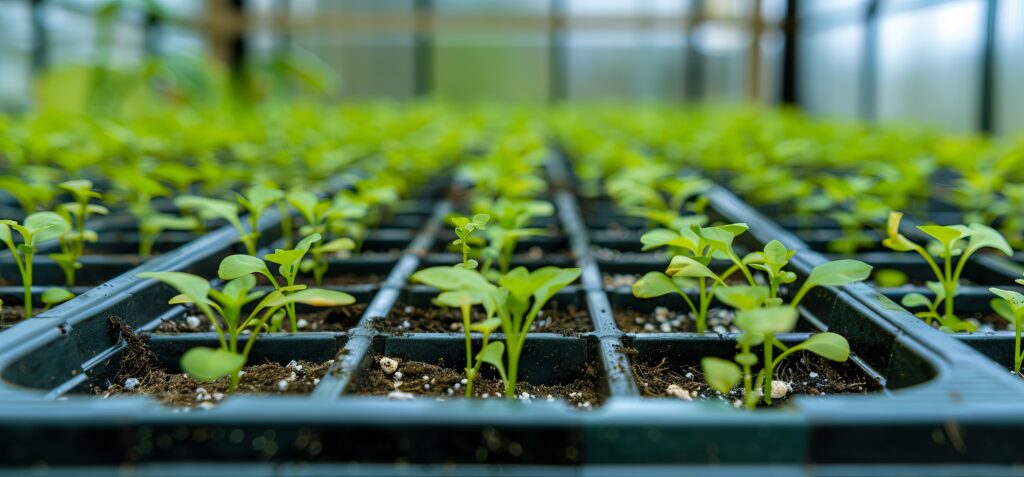Balancing Nutrients: Creating an Effective Fertilizer Program
When planning a fertilizer program, achieving the correct nutrient ratios and maintaining a balance between potentially acidic and potentially basic nutrient sources is essential. This balance not only optimizes plant growth but also ensures the stability of your growing medium’s pH over time. In this guide, we will delve deeper into the importance of pH balance, how nutrient ratios affect plant health, and how Plant-Prod’s water-soluble fertilizers can help you achieve consistent results.
Why Nutrient Ratios Are Crucial
Fertilizer formulations are designed to deliver essential nutrients to plants in precise ratios. These ratios ensure that plants receive a balanced diet, specific to their particular needs to supports healthy growth and maximum yield. Nutrients can be broken down into three main groups:
- Macronutrients: These primary nutrients are required at the highest level and support basic plant functions. These include Nitrogen, Phosphorus, Potassium.
- Secondary Nutrients: Required at moderate levels. Sources can sometimes come from external inputs such as water source. These include Calcium, Magnesium, Sulphur.
- Micronutrients: Required at very small amounts but are vital for optimal plant growth. These include Iron, Manganese, Zinc, Copper, Boron, Molybdenum.

Not only is the quality of these nutrients important, but so is their form and how they interaction with the growing media. Each nutrient has a unique impact on the surrounding root zone as it is taken up by the plant, making the media more acidic or basic. The nitrogen breakdown of your fertilizer has the most significant impact. This is based on the charge of each N ion and what happens when it’s taken up by the plant.
- Ammonium Nitrogen: Acidifies the medium, which can lower pH levels over time. Plants release an acidic H+ when taken up.
- Nitrate Nitrogen: Raises pH levels, creating a more basic environment. Plants release a basic OH– or HCO3– when taken up.
Maintaining the correct nutrient ratios through appropriate formulation selection and dosing is critical to maintaining ideal media pH and preventing nutrient lockout and ensure consistent growth.
The Role of Media pH in Plant Health
The pH of your growing medium is a key factor in nutrient availability. An imbalanced pH can lead to nutrient deficiencies (lock-out) or toxicities, even if the nutrients are present in adequate quantities. For example:
- Acidic Media (Low pH): Can cause micronutrients to become readily available at toxic levels, particularly with elements like iron and boron.
- Basic Media (High pH): May lead to deficiencies in phosphorus and several micronutrients, such as zinc and copper. At the same time, this can also lead to toxicity from calcium and magnesium.
Regularly monitoring the pH of your medium is essential for maintaining optimal conditions. Selecting fertilizers that align with your plants’ pH requirements and complement the existing characteristics of your growing medium will reduce the amount of media adjustments needed.
How to Balance Acidic and Basic Fertilizers
Due to material incompatibilities, formulations are generally available in 2 types – NPK and Cal-Mag. Generally, NPK formulations will have an acidic impact, while Cal-Mag formulations will have a basic impact. This is known as the fertilizer’s potential acidity or potential basicity. This is measured as a calcium carbonate equivalency. Since soilless growing media provides an optimal pH range at the beginning of a crop, we want to make sure that the fertilizer we’re adding doesn’t influence this pH in a negative way. Rotating the use of potentially acidic and potentially basic fertilizers allows you to effectively manage the pH of your growing medium.
Here are general steps to take for monitoring and adjusting media pH:
- Evaluate Your Starting pH: Test the pH of your growing medium to establish a baseline.
- Choose the Right Fertilizer: Select products with equally opposing weights of potential acidity and potential basically to balance their impact.
- Monitor Regularly: Continuously test your media pH to ensure that it remains within the optimal range for your crops.
- Adjust as Needed: If media pH begins to rise or fall, choose a fertilizer that will help to move the pH in the opposing direction as needed.
Plant-Prod’s Tailored Solutions for pH Management
Plant-Prod provides a range of high-quality water-soluble fertilizers that are formulated to help growers maintain optimal nutrient balance and media pH:
- Plant-Prod 20-8-20 (PA 216): A balanced, all-purpose NPK fertilizer. Ideal for general use across various crops and growing conditions.
- Plant-Prod 14-0-14 (PB 165): A balanced Cal-Mag fertilizer. Ideal for use in rotation with 20-8-20 to provide a balanced nutrient program.
- Plant-Prod 17-5-17 (PA 64): This complete formulation contains both NPK and Cal-Mag nutrients in one bag. Considered a neutral formulation, 17-5-17 is your solution to formulation rotation.
- Plant-Prod 21-7-7 Acid Special (PA 790): Contains a high proportion of ammonium nitrogen to help lower pH levels, making it ideal for crops that thrive in acidic media.
Each of these products is backed by years of research and development, ensuring reliable performance and consistent results.

Final Thoughts and Next Steps
Designing a fertilizer program that balances nutrients and pH requires a deep understanding of your crops’ needs and the characteristics of your growing medium. By incorporating Plant-Prod’s water-soluble fertilizers into your regimen, you can achieve healthier plants, higher yields, and more predictable outcomes.
Ready to optimize your fertilizer program? Visit our distributors page to connect with a supplier and discover how Plant-Prod’s innovative solutions can support your growing success.
